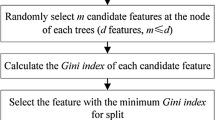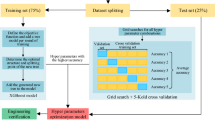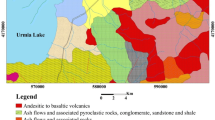Abstract
Rockburst prediction is of vital significance to the design and construction of underground hard rock mines. A rockburst database consisting of 102 case histories, i.e., 1998–2011 period data from 14 hard rock mines was examined for rockburst prediction in burst-prone mines by three tree-based ensemble methods. The dataset was examined with six widely accepted indices which are: the maximum tangential stress around the excavation boundary (MTS), uniaxial compressive strength (UCS) and uniaxial tensile strength (UTS) of the intact rock, stress concentration factor (SCF), rock brittleness index (BI), and strain energy storage index (EEI). Two boosting (AdaBoost.M1, SAMME) and bagging algorithms with classification trees as baseline classifier on ability to learn rockburst were evaluated. The available dataset was randomly divided into training set (2/3 of whole datasets) and testing set (the remaining datasets). Repeated 10-fold cross validation (CV) was applied as the validation method for tuning the hyper-parameters. The margin analysis and the variable relative importance were employed to analyze some characteristics of the ensembles. According to 10-fold CV, the accuracy analysis of rockburst dataset demonstrated that the best prediction method for the potential of rockburst is bagging when compared to AdaBoost.M1, SAMME algorithms and empirical criteria methods.
摘要
岩爆预测对地下硬岩矿山的设计和施工至关重要. 使用三种基于树的集成方法, 对由 102 个历史案例(即1998—2011 年期间 14 个硬岩矿山数据)组成的岩爆数据库进行了检查, 以用于有岩爆倾向矿井的岩爆预测. 该岩爆数据集包含六个广泛接受的倾向性指标, 即: 开挖边界周围的最大切向应力(MTS)、 完整岩石的单轴抗压强度(UCS)和单轴抗拉强度(UTS)、 应力集中系数(SCF)、 岩石脆性指数(BI) 和应变能储存指数(EEI). 以分类树作为基准分类器的两种 Boosting 算法(AdaBoost.M1, SAMME)和 Bagging 算法进行了评估, 评估了它们学习岩爆的能力. 将可用数据集随机分为训练集(整个数据集的 2/3)和测试集(其余数据集). 采用重复 10 倍交叉验证(CV)作为调整模型超参数的验证方法, 并利用边际分析和变量相对重要性分析了各集成学习模型特征. 根据重复 10 倍交叉验证结果, 对岩爆数据集的精度分析表明, 与 AdaBoost.M1、 SAMME 算法和岩爆经验判据相比, Bagging 方法是预测硬岩矿山岩爆的最佳方法.
Similar content being viewed by others
References
LI X, ZHOU J, WANG S, LIU B. Review and practice of deep mining for solid mineral resources [J]. Chinese Journal of Nonferrous Metals, 2017, 27(6): 1236–1262. DOI: https://doi.org/10.19476/j.ysxb.1004.0609.2017.06.021. (in Chinese)
ZHOU J, LI X, MITRI H S. Evaluation method of rockburst: State-of-the-art literature review [J]. Tunn Undergr Sp Tech, 2018, 81: 632–659. DOI: https://doi.org/10.1016/j.tust.2018.08.029.
LI X, GONG F, TAO M, DONG L, DU K, MA C, ZHOU Z, YIN T. Failure mechanism and coupled static-dynamic loading theory in deep hard rock mining: A review [J]. Journal of Rock Mechanics and Geotechnical Engineering, 2017, 9(4): 767–782. DOI: https://doi.org/10.1016/j.jrmge.2017.04.004.
KAISER P K, MCCREATH D R, TANNANT D D. Canadian rockburst research program 1990–1995, vols 1–6 [R]. Sudbury, Ontario: CAMIRO Mining Division, 1997.
ZHOU J, LI X B, SHI X Z. Long-term prediction model of rockburst in underground openings using heuristic algorithms and support vector machines [J]. Safety Science, 2012, 50(4): 629–644. DOI: https://doi.org/10.1016/j.ssci.2011.08.065.
GONG F Q, SI X F, LI X B, WANG S Y. Experimental investigation of strain rockburst in circular caverns under deep three-dimensional high-stress conditions [J]. Rock Mechanics and Rock Engineering, 2019, 52(5): 1459–1474. DOI: https://doi.org/10.1007/s00603-018-1660-5.
SI X, GONG F. Strength-weakening effect and shear-tension failure mode transformation mechanism of rockburst for fine-grained granite under triaxial unloading compression [J]. International Journal of Rock Mechanics and Mining Sciences, 2020, 131: 104347. DOI: https://doi.org/10.1016/j.ijrmms.2020.104347.
SHI X Z, ZHOU J, DONG L, HU H Y, WANG H Y, CHEN S R. Application of unascertained measurement model to prediction of classification of rockburst intensity [J]. Chinese Journal of Rock Mechanics and Engineering, 2010, 29(s1): 2720–2727. (in Chinese)
ORTLEPP W D. RaSiM comes of age—A review of the contribution to the understanding and control of mine rockbursts [C]// POTVIN Y, HUDYMA M. Controlling Seismic Risk — Proceedings of Sixth International Symposium on Rockburst and Seismicity in Mines. Australian Centre for Geomechanics, 2005: 3–20.
WENG L, HUANG L Q, TAHERI A, LI X B. Rockburst characteristics and numerical simulation based on a strain energy density index: A case study of a roadway in linglong gold mine, China [J]. Tunnelling & Underground Space Technology, 2017, 69: 223–232. DOI: https://doi.org/10.1016/j.tust.2017.05.011.
JIANG Q, FENG X T, XIANG T B, SU G S. Rockburst characteristics and numerical simulation based on a new energy index: A case study of a tunnel at 2,500 m depth [J]. Bulletin of Engineering Geology and the Environment, 2010, 69(3): 381–388. DOI: https://doi.org/10.1007/s10064-010-0275-1.
ZHU G A, DOU L M, CAO A Y, CAI W, WANG C B, LIU Z G, LI J. Assessment and analysis of strata movement with special reference to rock burst mechanism in island longwall panel [J]. Journal of Central South University, 2017, 24(12): 2951–2960. DOI: https://doi.org/10.1007/s11771-017-3709-0.
ZHOU J, LI X, MITRI H S. Classification of rockburst in underground projects: Comparison of ten supervised learning methods [J]. Journal of Computing in Civil Engineering, 2016, 30(5): 04016003. DOI: https://doi.org/10.1061/(ASCE)CP.1943-5487.0000553.
LUO Y, GONG F Q, LI X B, WANG S Y. Experimental simulation investigation of influence of depth on spalling characteristics in circular hard rock tunnel [J]. Journal of Central South University, 2020, 27(3): 891–910. DOI: https://doi.org/10.1007/S11771-020-4339-5.
MITRI H S, TANG B, SIMON R. FE modelling of mining-induced energy release and storage rates [J]. The Journal of the South African Institute of Mining and Metallurgy, 1999, 99(2): 103–110.
GONG F, YAN J, LI X, LUO S. A peak-strength strain energy storage index for rock burst proneness of rock materials [J]. International Journal of Rock Mechanics and Mining Sciences, 2019, 117: 76–89. DOI: https://doi.org/10.1016/j.ijrmms.2019.03.020
FENG X T, WANG L N. Rockburst prediction based on neural networks [J]. Transactions of Nonferrous Metals Society of China, 1994, 4(1): 7–14.
GONG F Q, LI X B. A distance discriminant analysis method for prediction of possibility and classification of rockburst and its application [J]. Chinese Journal of Rock Mechanics and Engineering, 2007, 26(5): 1012–1018. (in Chinese)
ZHOU J, SHI X Z, DONG L, HU H Y, WANG H Y. Fisher discriminant analysis model and its application for prediction of classification of rockburst in deep buried long tunnel [J]. Journal of Coal Science and Engineering, 2010, 16(2): 144–149. (in Chinese)
LIU Z, SHAO J, XU W, MENG Y. Prediction of rock burst classification using the technique of cloud models with attribution weight [J]. Natural Hazards, 2013, 2: 549–568. DOI: https://doi.org/10.1007/s11069-013-0635-9.
ADOKO A C, GOKCEOGLU C, WU L, ZUO Q J. Knowledge-based and data-driven fuzzy modeling for rockburst prediction [J]. International Journal of Rock Mechanics and Mining Sciences, 2013, 61: 86–95. DOI: https://doi.org/10.1016/j.ijrmms.2013.02.010.
ZHOU J, SHI X Z, HUANG R D, QIU X Y, CHEN C. Feasibility of stochastic gradient boosting approach for predicting rockburst damage in burst-prone mines [J]. Trans Nonferrous Meterol Soc China, 2016, 26: 1938–1945. DOI: https://doi.org/10.1016/S1003-6326(16)64312-1.
ZHOU J, GUO H, KOOPIALIPOOR M, ARMAGHANI D J, TAHIR M M. Investigating the effective parameters on the risk levels of rockburst phenomena by developing a hybrid heuristic algorithm [J]. Engineering with Computers, 2020: 1–16. DOI: https://doi.org/10.1007/s00366-019-00908-9.
LE L T, NGUYEN H, DOU J, ZHOU J. A comparative study of PSO-ANN, GA-ANN, ICA-ANN, and ABC-ANN in estimating the heating load of buildings’ energy efficiency for smart city planning [J]. Applied Sciences, 2019, 9(13): 2630. DOI:https://doi.org/10.3390/app9132630.
ZHOU J, LI C, ARSLAN C A, HASANIPANAH M, AMNIEH H B. Performance evaluation of hybrid FFA-ANFIS and GA-ANFIS models to predict particle size distribution of a muck-pile after blasting [J]. Engineering with Computers, 2019. DOI: https://doi.org/10.1007/s00366-019-00822-0.
ZHOU J, NEKOUIE A, ARSLAN C A, PHAM B T, HASANIPANAH M. Novel approach for forecasting the blast-induced AOp using a hybrid fuzzy system and firefly algorithm [J]. Engineering with Computers, 2020, 36(2): 703–712. DOI: https://doi.org/10.1007/s00366-019-00725-0.
MARZI H, HAJ DARWISH A, HELFAWI H. Training ANFIS using the enhanced Bees Algorithm and least squares estimation [J]. Intelligent Automation & Soft Computing, 2017, 23(2): 227–234. DOI: https://doi.org/10.1080/10798587.2016.1196880.
YU Z, SHI X, ZHOU J, CHEN X, MIAO X, TENG B, IPANGELWA T. Prediction of blast-induced rock movement during bench blasting: Use of gray wolf optimizer and support vector regression [J]. Natural Resources Research, 2020, 29(2): 843–65. DOI: https://doi.org/10.1007/s11053-019-09593-3.
ZHANG S. Cost-sensitive KNN classification [J]. Neurocomputing, 2020, 391: 234–242. DOI: https://doi.org/10.1016/j.neucom.2018.11.101.
HE M, XIA H, JIA X, GONG W, ZHAO F, LIANG K. Studies on classification, criteria and control of rockbursts [J]. Journal of Rock Mechanics and Geotechnical Engineering, 2012, 4(2): 97–114. DOI: https://doi.org/10.3724/SP.J.1235.2012.00097.
CAI W, DOU L, ZHANG M, CAO W, SHI J Q, FENG L. A fuzzy comprehensive evaluation methodology for rock burst forecasting using microseismi monitoring [J]. Tunnelling and Underground Space Technology, 2018, 80: 232–245. DOI: https://doi.org/10.1016/j.tust.2018.06.029.
AFRAEI S, SHAHRIAR K, MADANI S H. Developing intelligent classification models for rock burst prediction after recognizing significant predictor variables, Section 1: Literature review and data preprocessing procedure [J]. Tunnelling and Underground Space Technology, 2019, 83: 324–353.
GONG F Q, LI X B, ZHANG W. Rockburst prediction of underground engineering based on Bayes discriminant analysis method [J]. Rock and Soil Mechanics, 2010, 31(Suppl 1): 370–377. DOI: https://doi.org/10.1109/VETECS.2006.1683241. (in Chinese)
LI T Z, LI Y X, YANG X L. Rock burst prediction based on genetic algorithms and extreme learning machine [J]. Journal of Central South University, 2017, 24(9): 2105–2113. DOI: https://doi.org/10.1007/s11771-017-3619-1.
ZHOU J, KOOPIALIPOOR M, LI E, ARMAGHANI D J. Prediction of rockburst risk in underground projects developing a neuro-bee intelligent system [J]. Bulletin of Engineering Geology and the Environment, 2020, 5: 1–15. DOI: https://doi.org/10.1007/s10064-020-01788-w.
WANG C, WU A, LU H, BAO T, LIU X. Predicting rockburst tendency based on fuzzy matter-element model [J]. International Journal of Rock Mechanics and Mining Sciences, 2015, 75: 224–232. DOI: https://doi.org/10.1016/j.ijrmms.2015.02.004.
HASTIE T, TIBSHIRANI R, FRIEDMAN J. The elements of statistical learning: Data mining, inference, and prediction [M]. 2nd ed. New York: Springer-Verlag, 2009.
KIM M J, KANG D K. Ensemble with neural networks for bankruptcy prediction [J]. Expert Systems with Applications, 2010, 37(4): 3373–3379. DOI: https://doi.org/10.1016/j.eswa.2009.10.012.
CHOU J S, CHIEH L C. Predicting disputes in public-private partnership projects: Classification and ensemble models [J]. Journal of Computing in Civil Engineering, 2013, 27(1): 51–60. DOI: https://doi.org/10.1061/(ASCE)CP.1943-5487.0000197.
ZHOU J, SHI X, DU K, QIU X, LI X, MITRI H S. Feasibility of random-forest approach for prediction of ground settlements induced by the construction of a shield-driven tunnel [J]. International Journal of Geomechanics, 2017, 17(6): 04016129. DOI: https://doi.org/10.1061/(ASCE)GM.1943-5622.0000817.
BREIMAN L. Bagging predictors [J]. Machine Learning, 1996, 24(2): 123–140. DOI: https://doi.org/10.1007/BF00058655.
FREUND Y, SCHAPIRE R E. Experiments with a new boosting algorithm [C]// Proceedings of the Thirteenth International Conference on Machine Learning. Morgan Kaufmann, 1996: 148–156.
ZHU J, ZOU H, ROSSEZ S, HASTIE T. Multi-class AdaBoost [J]. Statistics and its Interface, 2009, 2: 349–360. DOI: https://doi.org/10.4310/SII.2009.v2.n3.a8.
BREIMAN L, FRIEDMAN J H, OLSHEN R A, STONE C J. Classification and regression trees [M]. Wadsworth, Belmont, 1984.
ALFARO E, GARCIA N, GAMEZ M, ELIZONDO D. Bankruptcy forecasting: An empirical comparison of AdaBoost and neural networks [J]. Decision Support Systems, 2008, 45: 110–122. DOI: https://doi.org/10.1016/j.dss.2007.12.002.
FARADONBEH R S, TAHERI A. Long-term prediction of rockburst hazard in deep underground openings using three robust data mining techniques [J]. Engineering with Computers, 2018, 35(2): 659–675. DOI: https://doi.org/10.1007/s00366-018-0624-4.
GHASEMI E, GHOLIZADEH H, ADOKO A C. Evaluation of rockburst occurrence and intensity in underground structures using decision tree approach [J]. Engineering with Computers, 2020, 36(1): 213–225. DOI: https://doi.org/10.1007/s00366-018-00695-9.
CLEVELAND W S. LOWESS: A program for smoothing scatterplots by robust locally weighted regression [J]. The American Statistician, 1981, 35: 54.
RUSSENES B F. Analysis of rock spalling for tunnels in steep valley sides (in Norwegian) [D]. Trondheim: Norwegian Institute of Technology, 1974.
KIDYBINSKI A. Bursting liability indices of coal [J]. International Journal of Rock Mechanics and Mining Sciences and Geomechanics Abstracts, 1981, 18(4): 295–304. DOI: https://doi.org/10.1016/0148-9062(81)91194-3.
WANG Y H, LI W D, LI Q G, XU Y, TAN G H. Method of fuzzy comprehensive evaluations for rockburst prediction [J]. Chinese Journal of Rock Mechanics and Engineering, 1998, 17(5): 493–501. (in Chinese)
ZHANG J J, FU B J, LI Z K, SONG S W, SHANG Y J. Criterion and classification for strain mode rockbursts based on five-factor comprehensive method [C]//Proceedings of the 12th ISRM International Congress on Rock Mechanics, Harmonising Rock Engineering and the Environment. London: Taylor & Francis Group, 2011: 1435–1440.
ZHANG G C, GAO Q, DU J Q, LI K K. Rockburst criterion based on artificial neural networks and nonlinear regression [J]. Journal of Central South University (Science and Technology), 2013, 44(7): 2977–2981. (in Chinese)
PENG Z, WANG Y H, LI T J. Griffith theory and rock burst of criterion [J]. Chinese Journal of Rock Mechanics and Engineering, 1996, 15(Suppl): 491–495. (in Chinese)
HOTHORN T, KURT HORNIK K, ZEILEIS A. Unbiased recursive partitioning: A conditional inference framework [J]. Journal of Computational and Graphical Statistics, 2006, 15(3): 651–674. DOI: https://doi.org/10.1198/106186006X133933.
VENABLES W N, RIPLEY B D. Modern applied statistics with S [M]. Springer, 2002.
GARZÓN M B, BLAZEK R, NETELER M, de DIOS R S, OLLERO H S, FURLANELLO C. Predicting habitat suitability with machine learning models: The potential area of Pinus Sylvestris L. in the Iberian Peninsula [J]. Ecol Model, 2006, 97: 383–393. DOI: https://doi.org/10.1016/j.ecolmodel.2006.03.015.
ALFARO E, GAMEZ M, GARCIA N. Adabag: An R package for classification with boosting and bagging [J]. Journal of Statistical Software, 2013, 54(2): 1–35. DOI: https://doi.org/10.18637/jss.v054.i02.
BREIMAN L. Arcing classifiers [J]. The Annals of Statistics 1998, 26(3): 801–849. DOI: https://doi.org/10.1214/aos/1024691079.
SCHAPIRE R E, FREUND Y, BARTLETT P, LEE W S. Boosting the margin: A new explanation for the effectiveness of voting methods [J]. The Annals of Statistics, 1998, 26(5): 1651–1686.
HE H, CAO Y. SSC: A classifier combination method based on signal strength [J]. IEEE Transactions on Neural Networks & Learning Systems, 2012, 23(7): 1100. DOI: https://doi.org/10.1109/TNNLS.2012.2198227.
GRINAND C, ARROUAYS D, LAROCHE B, MARTIN MP. Extrapolating regional soil landscapes from an existing soil map: Sampling intensity, validation procedures, and integration of spatial context [J]. Geoderma, 2008, 143: 180–190. DOI: https://doi.org/10.1016/j.geoderma.2007.11.004.
GONG F Q, LUO Y, LI X B, SI X F, TAO M. Experimental simulation investigation on rockburst induced by spalling failure in deep circular tunnels [J]. Tunnelling and Underground Space Technology, 2018, 81: 413–427. DOI: https://doi.org/10.1016/j.tust.2018.07.035.
TAO M, ZHAO H, LI X, LI X, DU K. Failure characteristics and stress distribution of pre-stressed rock specimen with circular cavity subjected to dynamic loading [J]. Tunnelling and Underground Space Technology, 2018, 81: 1–15. DOI: https://doi.org/10.1016/j.tust.2018.06.028.
SINGH S P. Classification of mine workings according to their rockburst proneness [J]. Mining Science and Technology, 1989, 8(3): 253–262. DOI: https://doi.org/10.1016/S0167-9031(89)90404-0.
BARTON N, LIEN R, LUNDE J. Engineering classification of rock masses for the design of tunnel support [J]. Rock Mechanics and Rock Engineering, 1974, 6(4): 189–236. DOI: https://doi.org/10.1007/bf01239496.
HOEK E, BROWN E T. Underground excavation in rock [M]. London: The Institute of Mining and Metallurgy, 1980.
MARTIN C, KAISER P, MCCREATH D. Hoek-Brown parameters for predicting the depth of brittle failure around tunnels [J]. Canadian Geotechnical Journal, 1999, 36: 136–151. DOI: https://doi.org/10.1139/cgj-36-1-136.
SINGH S P. The influence of rock properties on the occurrence and control of rockbursts [J]. Mining Science and Technology, 1987(5): 11–18. DOI: https://doi.org/10.1016/S0167-9031(87)90854-1.
XIE H. PARISEAU W G. Fractal character and the mechanism of rock bursts [J]. International Journal of Rock Mechanics and Mining Sciences & Geomechanics Abstracts, 1993, 30(4): 343–350. DOI: https://doi.org/10.1016/0148-9062(93)91718-X.
ZHOU J, QIU Y, ZHU S, ARMAGHANI DJ, LI C, NGUYEN H, YAGIZ S. Optimization of support vector machine through the use of metaheuristic algorithms in forecasting TBM advance rate [J]. Engineering Applications of Artificial Intelligence, 2021, 97: 104015.
THERNEAU T, ATKINSON E. An introduction to recursive partioning using the rpart routine [R]. Rochester: Section of Biostatistics, 1997.
ROSS I, ROBERT G. R: A language and environment for statistical computing. R foundation for statistical computing [J]. Journal of Computational and Graphical Statistics, 2008, 5: 299–314. DOI: https://doi.org/10.1890/0012-9658(2002)083[3097:CFHIWS]2.0.CO;2.
ZHOU J, LI X, MITRI H S. Comparative performance of six supervised learning methods for the development of models of hard rock pillar stability prediction [J]. Natural Hazards, 2015, 79(1): 291–316. DOI: https://doi.org/10.1007/s11069-015-1842-3.
KUNCHEVA L I. Combining pattern classifiers: Methods and algorithms [M]. New York: Wiley, 2004.
MITRI H S. Practitioner’s guide to destress blasting in hard rock mines [R]. Montreal: McGill University, 2000.
JIANG Q, YANG B, YAN F, LIU C, SHI Y, LI L. New method for characterizing the shear damage of natural rock joint based on 3D engraving and 3D scanning [J]. International Journal of Geomechanics, 2020, 20(2): 06019022. DOI: https://doi.org/10.1061/(ASCE)GM.1943-5622.0001575.
Author information
Authors and Affiliations
Contributions
WANG Shi-ming and ZHOU Jian provided the concept and wrote the original draft of manuscript. ZHOU Jian, LI Chuan-qi and Danial Jahed ARMAGHANI collected, visualized and analyzed dataset, conducted the models. LI Xi-bing and Hani S. MITRI edited the draft of manuscript.
Corresponding author
Ethics declarations
The authors declare that they have no conflicts of interest.
Additional information
Foundation item: Projects(41807259, 51604109) supported by the National Natural Science Foundation of China; Project(2020CX040) supported by the Innovation-Driven Project of Central South University, China; Project(2018JJ3693) supported by the Natural Science Foundation of Hunan Province, China
Rights and permissions
About this article
Cite this article
Wang, Sm., Zhou, J., Li, Cq. et al. Rockburst prediction in hard rock mines developing bagging and boosting tree-based ensemble techniques. J. Cent. South Univ. 28, 527–542 (2021). https://doi.org/10.1007/s11771-021-4619-8
Received:
Accepted:
Published:
Issue Date:
DOI: https://doi.org/10.1007/s11771-021-4619-8




